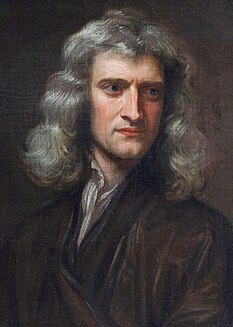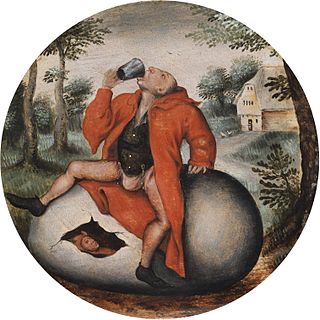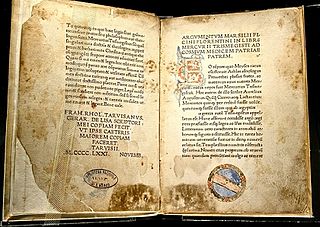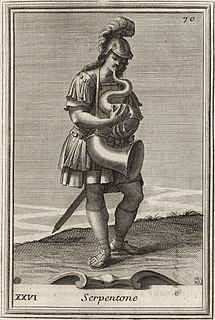
Sir Isaac Newton was an English mathematician, physicist, astronomer, theologian, and author who is widely recognised as one of the most influential scientists of all time and as a key figure in the scientific revolution. His book Philosophiæ Naturalis Principia Mathematica, first published in 1687, laid the foundations of classical mechanics. Newton also made seminal contributions to optics, and shares credit with Gottfried Wilhelm Leibniz for developing the infinitesimal calculus.

Athanasius Kircher was a German Jesuit scholar and polymath who published around 40 major works, most notably in the fields of comparative religion, geology, and medicine. Kircher has been compared to fellow Jesuit Roger Boscovich and to Leonardo da Vinci for his enormous range of interests, and has been honoured with the title "Master of a Hundred Arts". He taught for more than 40 years at the Roman College, where he set up a wunderkammer. A resurgence of interest in Kircher has occurred within the scholarly community in recent decades.

A codpiece is a covering flap or pouch that attaches to the front of the crotch of men's trousers, enclosing the genital area. It may be held closed by string ties, buttons, folds, or other methods. It was an important fashion item of European clothing during the fifteenth and sixteenth centuries. In the modern era, clothing devices with similar functions as codpieces are worn in some styles of underwear, in the leather subculture, and in performance costumes, such as for rock music and metal musicians. A similar device with rigid construction, an athletic cup, is used as protective underwear for male athletes.

Sir Thomas Browne was an English polymath and author of varied works which reveal his wide learning in diverse fields including science and medicine, religion and the esoteric. His writings display a deep curiosity towards the natural world, influenced by the scientific revolution of Baconian enquiry. Browne's literary works are permeated by references to Classical and Biblical sources as well as the idiosyncrasies of his own personality. Although often described as suffused with melancholia, his writings are also characterised by wit and subtle humour, while his literary style is varied, according to genre, resulting in a rich, unique prose which ranges from rough notebook observations to polished Baroque eloquence.

The Hermetica are Egyptian-Greek wisdom texts from the 2nd century or earlier, which are mostly presented as dialogues in which a teacher, generally identified as Hermes Trismegistus, enlightens a disciple. The texts form the basis of Hermeticism. They discuss the divine, the cosmos, mind, and nature. Some touch upon alchemy, astrology, and related concepts.

The Life of Gargantua and of Pantagruel is a pentalogy of novels written in the 16th century by François Rabelais, telling the adventures of two giants, Gargantua and his son Pantagruel. The work is written in an amusing, extravagant, and satirical vein; features much erudition, vulgarity, and wordplay; and is regularly compared with that of Shakespeare and James Joyce. Rabelais was a polyglot, and the work introduced "a great number of new and difficult words [...] into the French language".
The 1711 Sales Auction Catalogue of the Library of Sir Thomas Browne highlights the erudition of the physician, philosopher and encyclopedist, Sir Thomas Browne (1605-1682). It also illustrates the proliferation, distribution and availability of books printed throughout 17th century Europe which were purchased by the intelligentsia, aristocracy, priestly, physician or educated merchant-class.

Oedipus Aegyptiacus is Athanasius Kircher's supreme work of Egyptology.

The Alfred Jewel is a piece of Anglo-Saxon goldsmithing work made of enamel and quartz enclosed in gold. It was discovered in 1693, in North Petherton, Somerset, England and is now one of the most popular exhibits at the Ashmolean Museum in Oxford. It has been dated to the late 9th century, in the reign of Alfred the Great and is inscribed "AELFRED MEC HEHT GEWYRCAN", meaning "Alfred ordered me made". The jewel was once attached to a rod, probably of wood, at its base. After decades of scholarly discussion, it is now "generally accepted" that the jewel's function was to be the handle for a pointer stick for following words when reading a book. It is an exceptional and unusual example of Anglo-Saxon jewellery.

Cabinets of curiosities were collections of notable objects. The term cabinet originally described a room rather than a piece of furniture. Modern terminology would categorize the objects included as belonging to natural history, geology, ethnography, archaeology, religious or historical relics, works of art, and antiquities. The classic cabinet of curiosities emerged in the sixteenth century, although more rudimentary collections had existed earlier. In addition to the most famous and best documented cabinets of rulers and aristocrats, members of the merchant class and early practitioners of science in Europe formed collections that were precursors to museums.

Filippo Bonanni; S.J. or Buonanni was an Italian Jesuit scholar. His many works included treatises on fields ranging from anatomy to music. He created the earliest practical illustrated guide for shell collectors in 1681, for which he is considered a founder of conchology. He also published a study of lacquer that has been of lasting value since his death.

The Bembine Tablet, the Bembine Table of Isis or the Mensa Isiaca is an elaborate tablet of bronze with enamel and silver inlay, most probably of Roman origin but imitating the ancient Egyptian style. It was named in the Renaissance after Cardinal Bembo, a celebrated antiquarian who acquired it after the 1527 sack of Rome. Thereafter it was used by antiquarians to penetrate the meaning of Egyptian hieroglyphs, which were not authentically deciphered until the 19th century. Owing to these prior misconceptions, the tablet became of importance to western esoteric traditions.
George Starkey (1628–1665) was a Colonial American alchemist, medical practitioner, and writer of numerous commentaries and chemical treatises that were widely circulated in Western Europe and influenced prominent men of science, including Robert Boyle and Isaac Newton. After relocating from New England to London, England, in 1650, Starkey began writing under the pseudonym Eirenaeus Philalethes. Starkey remained in England and continued his career in medicine and alchemy until his death in the Great Plague of London in 1665.

Musaeum Hermeticum is a compendium of alchemical texts first published in German, in Frankfurt, 1625 by Lucas Jennis. Additional material was added for the 1678 Latin edition, which in turn was reprinted in 1749. Its purpose was apparently to supply in a compact form a representative collection of relatively brief and less ancient alchemical writings; it could be regarded as a supplement to those large storehouses of Hermetic learning such as the Theatrum Chemicum, or Jean-Jacques Manget's Bibliotheca Chemica Curiosa. It seemed to represent a distinctive school in Alchemy, less committed to the past and less obscure than the works of older and more traditional alchemical masters.

A carbuncle is any red gemstone, most often a red garnet.

The Renaissance saw the birth of Christian Kabbalah, also spelled Cabbala.
Events from the year 1656 in England.

Tripus Aureus or The Golden Tripod is an alchemical book by Michael Maier published in 1618 by Lucas Jennis. It contains three alchemical texts: The "twelve keys" of Basil Valentine, Thomas Norton's Ordinal of Alchemy (1477), and The Testament of Cremer.

The Twelve Keys of Basil Valentine is a widely reproduced alchemical book attributed to Basil Valentine. It was first published in 1599 by Johann Thölde who is likely the book's true author. It's presented as a sequence of alchemical operations encoded allegorically in words, to which images have been added. The first Basil Valentine book to discuss the keys is Ein kurtz summarischer Tractat, von dem grossen Stein der Uralten, 1599.

China Illustrata is the 1667 published book written by the Jesuit Athanasius Kircher (1602–1680) that compiles the 17th century European knowledge on the Chinese Empire and its neighboring countries. The original Latin title was: ”Athanasii Kircheri e Soc. Jesu China monumentis, qua sacris qua profanis, nec non variis Naturae et artis spectaculis, aliarumque rerum memorabilium argumentis illustrata, auspiciis Leopoldi primi, Roman. Imper. Semper augusti Munificentissimi Mecaenatis“.